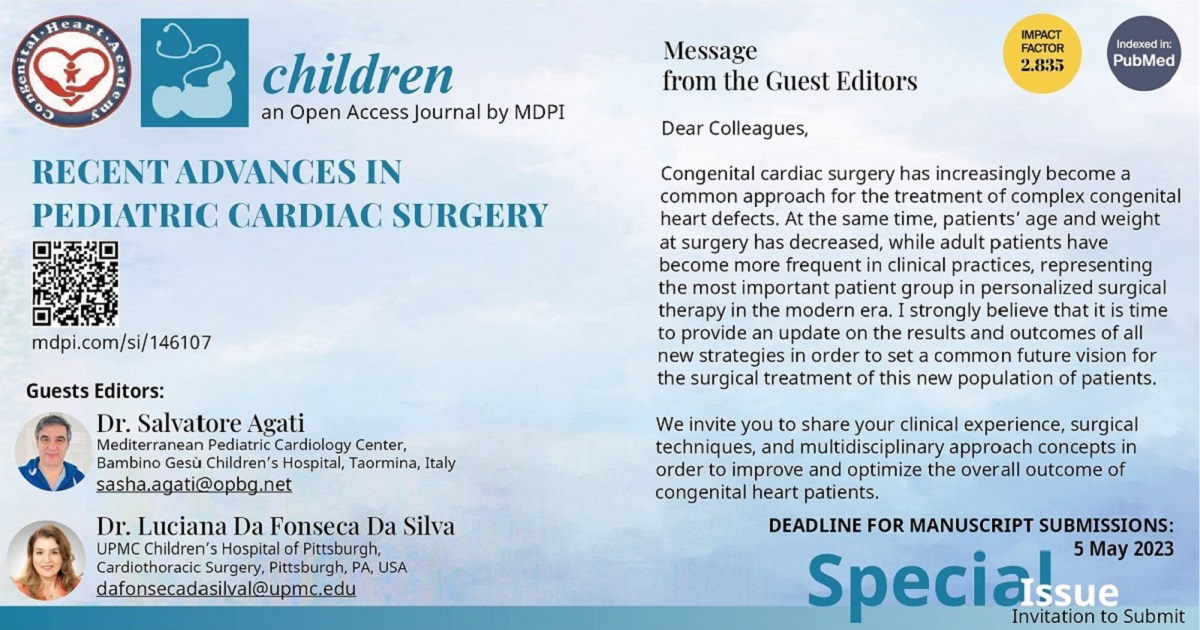Recent Advances in Pediatric Cardiac Surgery
A special issue of Children (ISSN 2227-9067). This special issue belongs to the section "Pediatric Cardiology".
Deadline for manuscript submissions: closed (20 January 2024) | Viewed by 6505

Special Issue Editors
Interests: congenital cardiac surgery; pediatric cardiology; congenital heart disease; cardiothoracic surgery
Special Issue Information
Dear Colleagues,
Congenital cardiac surgery has increasingly become a common approach for the treatment of complex congenital heart defects. At the same time, patients’ age and weight at surgery has decreased, while adult patients have become more frequent in clinical practices, representing the most important patient group in personalized surgical therapy in the modern era. I strongly believe that it is time to provide an update on the results and outcomes of all new strategies in order to set a common future vision for the surgical treatment of this new population of patients. We invite you to share your clinical experience, surgical techniques, and multidisciplinary approach concepts in order to improve and optimize the overall outcome of congenital heart patients.
Dr. Salvatore Agati
Dr. Luciana Da Fonseca Da Silva
Guest Editors
Manuscript Submission Information
Manuscripts should be submitted online at www.mdpi.com by registering and logging in to this website. Once you are registered, click here to go to the submission form. Manuscripts can be submitted until the deadline. All submissions that pass pre-check are peer-reviewed. Accepted papers will be published continuously in the journal (as soon as accepted) and will be listed together on the special issue website. Research articles, review articles as well as short communications are invited. For planned papers, a title and short abstract (about 100 words) can be sent to the Editorial Office for announcement on this website.
Submitted manuscripts should not have been published previously, nor be under consideration for publication elsewhere (except conference proceedings papers). All manuscripts are thoroughly refereed through a single-blind peer-review process. A guide for authors and other relevant information for submission of manuscripts is available on the Instructions for Authors page. Children is an international peer-reviewed open access monthly journal published by MDPI.
Please visit the Instructions for Authors page before submitting a manuscript. The Article Processing Charge (APC) for publication in this open access journal is 2400 CHF (Swiss Francs). Submitted papers should be well formatted and use good English. Authors may use MDPI's English editing service prior to publication or during author revisions.
Keywords
- congenital heart disease
- neonate
- preterm
- congenital cardiac surgery
- ECMO
Benefits of Publishing in a Special Issue
- Ease of navigation: Grouping papers by topic helps scholars navigate broad scope journals more efficiently.
- Greater discoverability: Special Issues support the reach and impact of scientific research. Articles in Special Issues are more discoverable and cited more frequently.
- Expansion of research network: Special Issues facilitate connections among authors, fostering scientific collaborations.
- External promotion: Articles in Special Issues are often promoted through the journal's social media, increasing their visibility.
- Reprint: MDPI Books provides the opportunity to republish successful Special Issues in book format, both online and in print.
Further information on MDPI's Special Issue policies can be found here.






